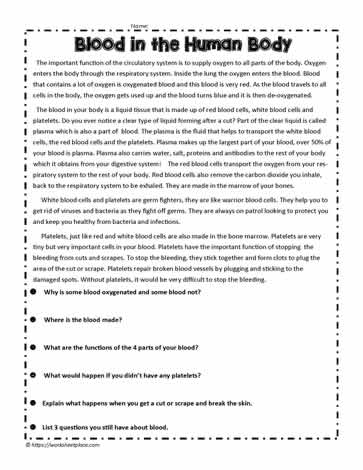| |||||
| Circulatory System Blood Comprehension For Google Apps | |||||
| What does the circulatory system do? It supplies oxygen to our bodies. Why is some oxygenated and some not? What happens when you get a scrape or cut that breaks the skin? What would happen if you did not have any platelets? Find out this information and more as you read the text and then answer the questions. Sometimes the circulatory system is referred to as the cardiovascular system. Your circulatory system is like a transportation system involving the heart, the arteries, blood and the veins. The main function of the circulatory system it to transport and deliver blood, nutrients and oxygen to all parts of your body. Your heart beats approximately 100,000 times a day to help your nutrient rich blood travel to all the parts of your body. Your heart acts like the pumping station and this hard working muscle is only about the size of your fist! Your heart is protected by your ribcage and is located slightly left in your chest. The blood in your body travels all around your body in small, straw like tubes called blood vessels. The vessels that are called arteries, transport the blood which is red, away from your heart and the vessels that are called veins transport the blood which is blue, back to your heart. Your blood is made up of three types of cells, red blood cells, white blood cells and platelets. The red blood cells carry the oxygen, the white blood cells are part of your immune system and help you to fight disease and infections, and the platelets fix or repair cut or torn skin and blood vessels. Your body gets its oxygen and nutrients from the blood that circulates through your body. The right side of your heart (atrium and ventricle) receives the blood that is returning to the heart to get cleaned up, it pumps it to the lungs to exchange the carbon dioxide from your blood with oxygen. The left side of your heart (atrium and ventricle) take the freshly oxygenated blood and deliver it to the rest of your body. The blood that is returning to the left chamber is high in carbon dioxide which is why that blood is blue. The blood coming out of the right side of your heart has been oxygenated and that is why it is red. You see evidence of red blood when you cut yourself and evidence of blue blood as you look at your veins near your skin. Your cells, which occupy every part of your body can’t do their work unless they have constant supplies of oxygen. Like other body systems, your circulatory system works together with your respiratory system to provide the oxygen to your blood which travels to all parts of your body. To keep the blood flowing in the right direction, your heart and most of your veins have valves. | |||||

All worksheets are created by experienced and qualified teachers. Send your suggestions or comments.